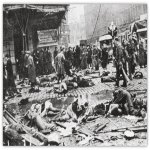Dark Alley Dan
CGN Ultra frequent flyer
- Location
- Darkest Edmonton
That's an amazing picture. Someone's gonna have a very bad day in a second or two...
Skyraiders were, and still are, impressive aircraft. Here's one with a tumor:


Everybody has their own takeaways. I've fired a variety of FA weapons over many years of service and did own and shoot both an M1A1 and M1928A1 Thompson. Funny, I always liked the Sterling fired with the butt in the belly. Another fun one was the M3 Grease-gun.
At one point in time Cutts Compensators were quite the rage in the shotgun world, but you seldom hear about them anymore. I think it was kind of like gilding the lily.
Cutts Compensators lost favour as they increased muzzle blast to adjacent shooters. They were current in the era when "real men" didn't wear hearing protection. They manfully went deaf.
LOL ....That might be but I havent fired a Thompson with or without a compensator - but I think there are a great many people who have actually used firearms with these compensators that might disagree with you. I have fired various 7.62, 9mm and 5.56 weapons on automatic from a standing unsupported position as this young lady has demonstrated and experienced significantly more muzzle climb than she apparently has. I dont think that the old timers were anymore gullible about false advertising than we are today and no doubt wanted to satisfy themselves that the extra cost of the Cutts was worth it before they bought one as an option. Maybe Ganderite who I believe has access to a Thompson can comment??



That's an amazing picture. Someone's gonna have a very bad day in a second or two...
Skyraiders were, and still are, impressive aircraft. Here's one with a tumor:


Jon Blanchette, working on his still airworthy MiG-17PF, originally acquired in 1994 for US$16,000.


Ha ha ha the irony in that photo....bought the aircraft for $16000 but probably worth many multiples of that now...

Teniersplaats, 27 november 1944, een V2 inslag op het drukke middaguur. Met als gevolg 154 doden en 309 ernstig gewonden

Ha ha ha the irony in that photo....bought the aircraft for $16000 but probably worth many multiples of that now...and he's working on it with a knuckle-buster Crescent wrench.
It cost him a small fortune and many years to get it in flying condition. He can't afford upkeep any more and it is/was up for sale.
https://www.airspacemag.com/flight-today/restoration-mig17-180970367/
I've heard from a very interested fellow that the owner was offered US$7 million for it, where is as is. He's holding out for more.
TURF THE LIBERALS IN 2019
Liberals really like POOR people, they're making more of them every day
If you can't vote CPC, stay at home in protest









































